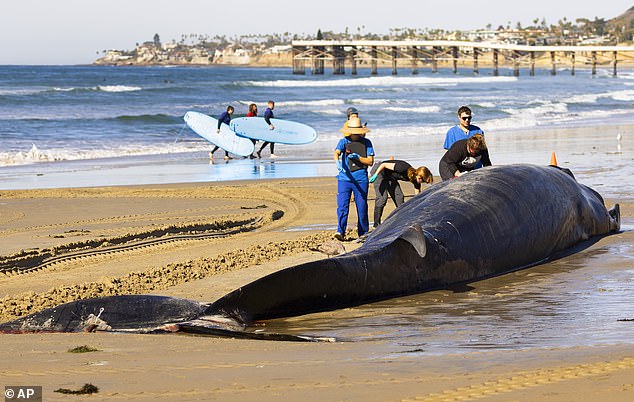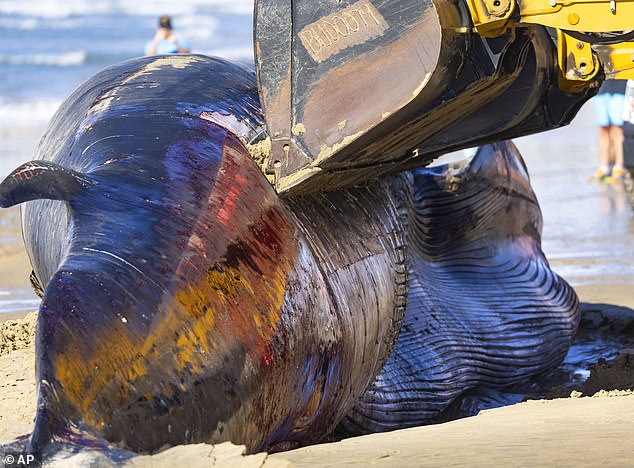Scientists FINALLY crack case of dead fin whale that washed up in California – but are horrified to discover the marauding beasts that killed it
- On December 10, the body of a 50-foot-long juvenile female fin whale washed up on Pacific Beach, bearing zigzag and striped scars.
- Initially scientists thought a shark had caused the wounds, but experts revealed the real culprit is killer whales
- The number of orcas off the coast of California has increased this year in what viewers are calling the season of 'Killer Whale Madness'
Scientists have discovered the gruesome cause of death of an endangered fin whale that washed ashore in San Diego earlier this month.
On December 10, the body of a 50-foot-long juvenile female fin whale washed up on Pacific Beach, bearing zigzag and striped scars. NBC7.
Researchers from the National Oceanic and Atmospheric Administration (NOAA) originally thought the bite marks came from sharks, but were shocked to learn what the real culprit was.
Michael Milstein, a NOAA spokesman, said a group of experts who investigated the case determined the scars were “rake marks” and were considered a killer whale signature.
“There have been other documented cases of killer whales chasing fin whales that beached themselves while trying to escape,” Milstein says.
On December 10, the body of a 50-foot-long juvenile female fin whale washed up on Pacific Beach, bearing zigzag and striped scars.

Researchers from the National Oceanic and Atmospheric Administration (NOAA) originally thought the bite marks came from sharks, but were shocked to learn that the real culprit was killer whales.
This whale seemed healthy in every other way, so scientists were perplexed as to why she had thrown herself ashore.
'We were surprised. The animal appeared healthy based on its body condition and how robust it was,” said Kerri Danil, a research biologist with the National Marine Fisheries Service who examined the whale. The Washington Post.
According to Milstein, fin whales are endangered and considered “fairly rare.” They are the second largest whale species after the blue whale, and believe this whale could weigh up to 100,000 pounds.
When her carcass washed ashore, the whale appeared to be bleeding from its side. Lifeguards tried to move her body out to sea, but were unable to.
There has been an increase in fatalities in sightings off the coast of California.
Earlier this month, an orca was spotted near San Diego engaged in a harrowing game of cat and mouse with a dolphin.
In a more recent sighting, the marine mammals were seen actively chasing and biting a dolphin, all unfolding within visible range of California mariners and tourists.

Fin whales are endangered and considered 'fairly rare'. They are the second largest whale species after the blue whale, and believe this whale could have weighed up to 100,000 pounds.

When her carcass washed ashore, the whale appeared to be bleeding from its side. Lifeguards tried to move her body out to sea

Michael Milstein, a NOAA spokesman, said a group of experts who investigated the case determined the scars were “rake marks” and were considered a killer whale signature.
Observers have dubbed the season “Killer Whale Madness,” calling the sighting a “once in a lifetime experience.”
Orcas typically travel in groups of up to 40 members.
Each pod has its own distinct clicking sound, making it easy for members to recognize and communicate with each other.
Of the three species of killer whales, it is estimated that nearly 200 transient killer whales live off the coast of California, hunting marine mammals.
Orca migration patterns are unpredictable. They appear sporadically, meaning the chance of seeing them off the coast of California is fleeting.
